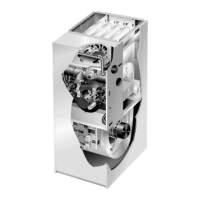Page 36
TABLE 23
Conversion Kit Requirements
for Models −070, −090, −110 and −135
Input
High Altitude Pressure Switch Kit
ORDER TWO EACH
LPG/Propane Kit LPG/Propane to
Natural Gas Kit
611 − 1372 m 0 − 610 m 611 − 1372 m 0 − 610 m 611−1372 m
−070 56M23 44W48 44W48 44W49 44W49
−090 56M23 44W48 44W48 44W49 44W49
−110 75M22 44W48 44W48 44W49 44W49
−135 Not allowed 44W48 Not allowed 44W49 Not allowed
NOTE − Pressure switch is factory set. No adjustment necessary. All models use the factory installed pressure switch from 0−4500 feet (0−1372 m).
*Two pressure switch assemblies required per unit.
TABLE 24
Fuel
Manifold Pressure (Outlet) at High Fire − kPa
Altitude − m
0−610
1
611−914
1
915−1219
1
1220−1372
Natural 0.87 0.80 0.75 0.70
2
LPG/Propane 2.49 2.29 2.12 2.02
1
High Altitude Pressure Switch Kits required for certain models, see Gas Heat Accessories table for order number.
2
LPG/Propane conversion kit required, see Gas Heat Accessories table for order number.
Other Unit Adjustments
Primary and Secondary Limits
The primary limit is located on the heating compartment
vestibule panel. The secondary limits are located in the
blower compartment, attached to the back side of the blow-
er. These limits are factory set and require no adjustment.
Flame Rollout Switches (Two)
These manually reset switches are located on the burner
box. If tripped, check for adequate combustion air before
resetting.
Pressure Switches (Two or Four)
The pressure switches are located in the heating compart-
ment on the combustion air inducer. These switches check
for proper combustion air inducer operation before allow-
ing ignition trial. The switches are factory−set and require
no adjustment.
Back−Up Secondary Limit (090, 110 & 135 Models)
The back−up secondary limit is located on the combustion
air inducer. This switch protects the plastic components
from overheating due to indoor blower motor failure. If
tripped, check for proper blower operation before resetting.
Temperature Rise
After the furnace has been started and supply and return air
temperatures have been allowed to stabilize, check the
temperature rise. If necessary, adjust the blower speed to
maintain the temperature rise within the range shown on
the unit nameplate. Increase the blower speed to decrease
the temperature. Decrease the blower speed to increase
the temperature rise. Failure to do adjust the temperature
rise may cause erratic limit operation.
Thermostat Heat Anticipation
Set the heat anticipator setting (if adjustable) according to
the amp draw listed on the wiring diagram that is attached
to the unit.
Electrical
1 − Check all wiring for loose connections.
2 − Check for the correct voltage at the furnace (furnace
operating).
3 − Check amp-draw on the blower motor.
Motor Nameplate__________Actual__________
NOTE − Do not secure the electrical conduit directly to the
air ducts or structure.
Electronic Ignition
The integrated control has an added feature of an internal
Watchguard control. The feature serves as an automatic re-
set device for ignition control lockout caused by ignition fail-
ure. This type of lockout is usually due to low gas line pres-
sure. After one hour of continuous thermostat demand for
heat, the Watchguard will break and remake thermostat de-
mand to the furnace and automatically reset the control to
begin the ignition sequence.
Exhaust and Air Intake Pipe
1 − Check exhaust and air intake connections for tightness
and to make sure there is no blockage.
2 − Are pressure switches closed? Obstructed exhaust
pipe will cause unit to shut off at pressure switches.
Check exhaust pipe and termination for blockages.
3 − Reset manual flame rollout switches on burner box
cover.
Failure To Operate
If the unit fails to operate, check the following:
1 − Is the thermostat calling for heat?
2 − Are access panels securely in place?
3 − Is the main disconnect switch closed?
4 − Is there a blown fuse?

